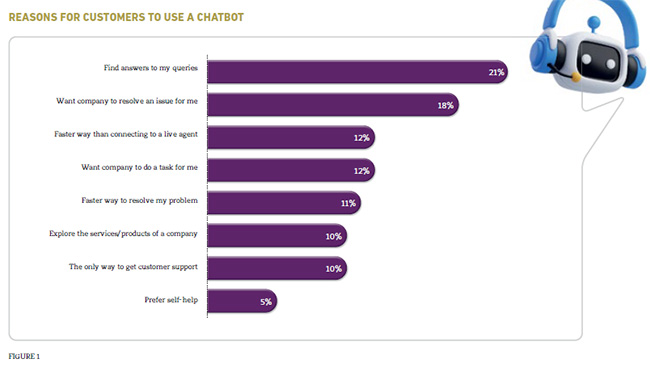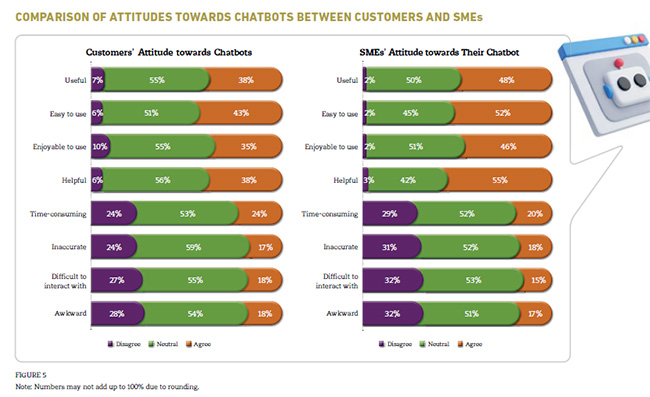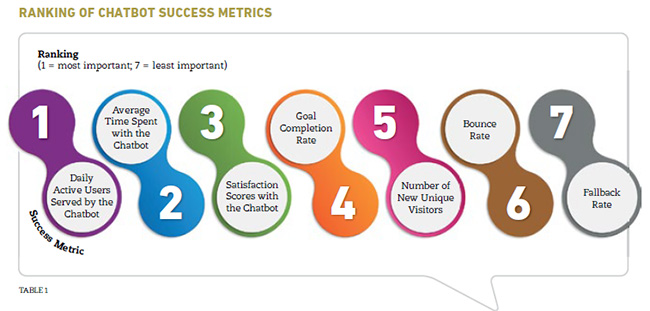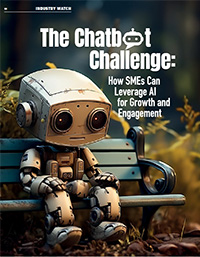Enhancing SME workforce efficiency with chatbots for improved business communication.
Chatbots have experienced explosive growth in the last decade, with the global market expected to grow from US$190 million in 2016 to a projected US$1.25 billion by 2025.1 In Asia, the use of this technology surged notably during the COVID-19 pandemic when some 63 percent of Internet users interacted with businesses in this manner.2 From ChatGPT to Google Bard to many other Artificial Intelligence (AI)-based conversational tools currently in the works, there is no lack of attention from all stakeholders involved–businesses/brands, developers, and consumers.
Small and medium enterprises (SMEs), which represent over 95 percent of the region’s businesses and account for nearly 70 percent of its workforce,3 are increasingly getting into the AI-chatbot game, but there is a lack of coordinated research on how best to leverage such emerging technologies. SMEs often have a limited understanding of consumers’ expectations regarding chatbots, the costs to build and maintain a chatbot system, and how to measure the effectiveness of chatbots.
In a recent study on Singapore SMEs, we explored the perceptions and attitudes regarding chatbot use in business communication. The following is a brief discussion of how SMEs can best allocate their chatbot budget, and ways to overcome organisational obstacles against successful chatbot implementation.
CHATBOTS ARE TOOLS, NOT ENTERTAINMENT SOURCES
Almost 80 percent of local consumers surveyed interact with businesses via a chatbot,4 making Singapore an excellent candidate for filling the knowledge gap. After surveying over 500 customers and 400 SMEs (four in five were bigger SMEs that employed 51 to 200 employees), one thing became clear: customers use chatbots to find answers to a query or resolve specific issues. The top two responses in Figure 1 illustrate clearly that these are the two main reasons for customers using a chatbot, while some respondents chose to do so believing that their goals would be achieved more quickly than if they had called a hotline.

To that end, Singapore SMEs are investing in chatbots for the right reasons. Forty percent of SME respondents cited either product/service support or the answering of customer questions as the reason for building a chatbot, with another 13 percent pointing to the filtering of customer questions as the main driver (see Figure 2). Cutting expenses on human service agents was the sixth most frequently cited reason, suggesting that fears of machines replacing humans might have been overplayed.

So far, so good. But here is where there is a misalignment between customers’ expectations of chatbots and businesses’ beliefs about what chatbots should perform well in. While three quarters (75 percent) of customers reported having their queries or problems addressed by the chatbots, less than half (46 percent) thought the process was efficient. Companies found that even natural language processing (NLP)—a branch of AI and machine learning that typically requires technical expertise and higher expenditure–was insufficient for chatbots to fully understand queries, which necessitated further tweaking.
Whereas about a quarter of SMEs surveyed operated machine-learning based systems, over six in 10 SMEs taking part in the survey deployed rule-based chatbots that feature branching questions that lead to the most appropriate pre-stored answer based on a user’s input. The rest deployed simple menu-based chatbots that work like automated phone menus (e.g., “Press ‘1’ for credit card, press ‘2’ for savings account”).
Only seven percent of SMEs surveyed had voice-based systems, which might be more intuitive or natural than pressing buttons, be they on a screen or physical ones. While these systems may not be the most expensive in terms of one-time installation charges (refer to Figure 3), they cost more to run and maintain (refer to Figure 4). This partially explains the popularity of rule-based chatbots that generally cost the least to set up and incur lower monthly maintenance expenses via-à-vis those for machine learning.

The low adoption rate for voice-based chatbots is consistent with the key survey finding that customers use chatbots as a functional tool, rather than as an open-ended exploration software. It also aligns with a separate study we did on businesses naming their chatbots in an attempt to impart some personality or human-like qualities, otherwise known as anthropomorphism.5 In that study, customers cared little for a chatbot’s ‘personality’ or gender. Instead, they preferred the chatbot to identify itself as one to manage expectations. This is because some customers may communicate differently depending on whether they interact with a machine or a human being.6 There was no clear preference among customers on whether a chatbot should have a name.
In short, the recommendation is that businesses should focus on a chatbot’s functionality, instead of making it entertaining or humorous. The lack of appreciation for that fundamental point may have contributed to SMEs slightly overestimating their chatbots’ positive attributes relative to customers’ perceptions, but businesses generally have a good grasp of the chatbots’ limitations (see Figure 5). SMEs might also exhibit anchoring bias, i.e., “We have spent so much money on this, it has to be good!” Even if that were true, SMEs did realise that their chatbots could still have shortcomings.

IT'S ABOUT PEOPLE, NOT TECHNOLOGY
Despite common perceptions of chatbots being a tolerated but useful inconvenience, we found that chatbots (28 percent) and phone calls (29 percent) are the top two options which customers prefer to use when contacting businesses. Nearly 80 percent of customers discovered a company’s chatbot either on their website’s support page or via a pop-up elsewhere on the company website.
SMEs should view chatbots not just as a tool for customer support, but as a strategic asset that can enhance customer experience, provide valuable insights, and improve operational efficiency. Customers expect alternative business communication channels, such as chatbots, to get their problems resolved quickly and efficiently. However, the similar levels of preference for chatbots and phone calls suggest that human interaction remains important, and SMEs should provide options for customers to easily switch to human support when needed.
Our survey found that nearly 88 percent of SMEs outsourced the design and building of chatbots to external vendors due to the perceived technical difficulty of the endeavour. Because the survey period was completed shortly after the public launch of OpenAI’s ChatGPT in late 2022,7 the survey results could be read as reflecting the ‘pre-ChatGPT’ era of business chatbot use, and perhaps decision-makers might come to view chatbot-building as less intimidating. More pertinently, new technology might create chatbots that offer more than just a direct answer to a specific question. If that had happened, would customers have been interested in having those conversations with chatbots, instead of just using them to resolve problems or answer queries?
But before all that can come to pass, businesses must first get their chatbots up and running. More than a perceived lack of technical skills, SMEs cited organisational pushback as the biggest challenge to implementing a chatbot. Senior management are often the champions of chatbot projects, which was reflected in our survey results where CEOs or Chief Executive Officers (24 percent), CTOs (Chief Technology Officers)/Tech Leads (21.9 percent), and COOs (Chief Operations Officers)/Operations Leads (15 percent) were the ones pushing for chatbots in SMEs. Such a top-down approach often triggers pushback from others in the organisation.
To mitigate organisational pushback and enhance the integration of chatbots, senior management should focus on educating their teams about the benefits and potential applications of chatbots. This involves not just technical training but also an understanding of how chatbots can add value to the business, streamline processes, and improve customer experience. Furthermore, it is crucial for leadership to emphasise that digital transformation, including the adoption of chatbots, is as much about people as it is about technology. By prioritising knowledge transfer and involving employees in the process, businesses can foster a more inclusive and supportive environment for successful digital transformation.
If all else fails, there is (almost) always a live agent to fall back on. The majority of the SMEs’ chatbots (88.5 percent) have a function to connect to a live agent either on request or as an option after the chatbot interaction. While the former might represent ‘fallback’ or a failure by the chatbot to understand what a customer wants, it might not bother SMEs that much–‘fallback rate’ was ranked at the bottom of seven metrics that SMEs used to measure a chatbot’s effectiveness (see Table 1). Instead, ‘daily active users served by the chatbot’ was deemed the most important success metric.

While SMEs focus on the number of users interacting with their chatbots and the duration of those interactions, the effectiveness of these interactions is not receiving enough attention. For instance, if a customer spends a lot of time talking to a chatbot but it does not resolve their issue, that is not an accurate measure of effectiveness.
Rather, small businesses should pay more attention to whether chatbots are actually resolving issues effectively. It is important to look at how well chatbots complete tasks and handle difficult questions. Shifting the focus to these outcome-based metrics could give a more accurate picture of a chatbot’s value to both the customer and the business.
PRACTICAL CONSIDERATIONS FOR BUSINESSES
For SMEs that have already incorporated chatbots into their customer service strategies, the effect is not just seen on the bottom line. They are often deployed with specific goals in mind—to improve call and chat handling times, and provide quick and accurate responses—which they do. However, SMEs must realise the true potential of these chatbots can be further unlocked. The next frontier would be to train chatbots to handle complex queries, and for all this initial information to provide an evermore tailored and accurate experience every time. Just as importantly, SMEs need to invest in continuous improvement, as chatbot references keep evolving both as their customers increasingly use AI-powered virtual assistants, and general technology advances.
The starting point for SMEs taking their first steps towards AI transformation remains the same: identifying the core needs of their customers. This first step is crucial as it ensures the chatbot will be functional and serve a purpose, rather than be a novelty. When deploying your first chatbot, keep the scope clear and manageable, and set clear, achievable goals, whether it is to reduce time spent on answering generic queries or delivering around-the-clock basic support. Once it has proved its worth and you have gained confidence, you can increase the importance of the chatbot as part of your customer service strategy.
Introducing more advanced generative AI does not change any of these fundamental lessons but it does mean we need to be even more alert and responsive to new capabilities that will keep emerging. SMEs need to prepare for a world where customer expectations will be set by the cutting-edge digital technology they interact with, not the ageing last release.
The feedback loop is essential. Establish mechanics for capturing customer feedback on chatbot interactions directly. Review this feedback regularly, not just in terms of content, but also sentiment and satisfaction levels, to ensure that both AI and human learn and adapt accordingly.
THE SME CHATBOT CHALLENGE: BALANCING HUMAN TOUCH AND AI
Generative AI technology is getting faster and better all the time and as it does, it will change customer expectations. SMEs are at the forefront of that shift. Today, for instance, chatbots for business communication represent one of the main uses of generative AI. To gain the most value from digital transformation, it is important not to just understand the capabilities of chatbots, but also how they can better provide for human needs–the heart of all successful customer service, whatever generative AI may bring.
So, no matter how advanced chatbots become, they must continue to be able to address the genuine needs of the customer, while SMEs need to understand what the generative technology behind their chatbots can add to their service capabilities to improve the customer experience. All this while, the success of the business will still rest on its ability to identify and fulfil true customer needs with functional value (top line) and a commitment to continuous improvement as increasing functionality propels chatbots into uncharted waters.
Dr Tamas Makany
is Associate Professor of Communication Management at Lee Kong Chian School of Business, Singapore Management University
Felicia Goh
is Research Assistant at School of Social Sciences, Singapore Management University
Endnotes
1. Statista, “Size of the Chatbot Market Worldwide from 2016 to 2025”, November 22, 2023.
2. Makebot.AI, “2022 Asia Chatbot Trend Report”.
3. Asian Development Bank, “Asia Small and Medium-Sized Enterprise Monitor 2020: Volume I–Country and Regional Reviews”, October 2020.
4. Ibid.
5. Tamas Makany, Sungjong Roh, Kotaro Hara, et al., “Beyond Anthropomorphism: Unraveling the True Priorities of Chatbot Usage in SMEs”, CUI ’23: Proceedings of the 5th International Conference on Conversational User Interfaces, July 19, 2023.
6. Ibid.
7. The survey was conducted from December 14, 2022 to January 13, 2023. The sample size was 907, comprising 504 and 403 respondents from the customer and SME populations respectively.
